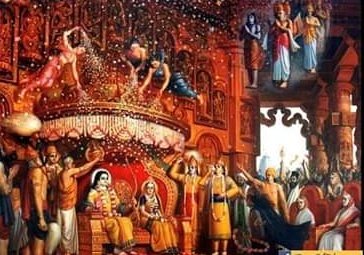Ayodhya: The place which can’t be conquered in a war
Ayodhya means one which can’t be conquered in a war. Ayodhya A+yudhya which can’t be won in “ yuddha” that city of supreme Lord Rama is known as Ayodhya. Ayodhya is the legendary place where Lord Rama was born.
Ayodhya is also sometimes referred to as Ram Janmabhoomi (“Rama’s birthplace”). The town is located on the banks of river Sarayu, also spelled Saryu. There is a surfeit of temples in this town, numbering over 100.
Important places to visit in Ayodhya
The Temple of Rama and his consort Sita is called the Kanak Bhavan; the Hanuman temple is called the Hanuman Garhi on top of a hill where, apart from a Hanuman statue in a sitting posture.

There is also a 6 inches (15 cm) tall image of Hanuman always bedecked by flowers; the Kshireshwaranath temple of Sita, established by Kausalya, Rama’s mother. In addition, there are several kunds or ponds and ghats.
(bathing steps to approach river or tank water level) with linkage to characters; such as the Brahma kund built in honor of Brahma’s visit here, Sita kund, Bharat kund, Lakshman ghat where Lakshman, Rama’s brother took a bath, and Rama ghat.
(also called Swargadwar meaning gateway to heaven). There is a legend related to Kusha, son of Rama, in support of the Nageshwaranath temple here. The armlet, which Kusha had lost in the Sarayu river was found by a nag-Kanya (a damsel of the serpent family),

a devotee of Lord Shiva, who fell in love with Kusha. A temple was built by Kusha in her honor and is stated to be the only surviving ancient temple dated to the reign of Vikramaditya.
History of Ayodhya Ram Mandir
The historical legacy of this place is traced to the sixth century BC, as established by archaeological and literary references. Ramayana epic is traced to the late centuries of BC of the Ikshvaku Dynasty and the early centuries of AD. Dasaratha, father of Rama belonged to this dynasty.
Invasions by Mughals
‘Mughal emperor Babar, who had come to India along with other Muslim forces looted the Mandir and tried to finish out the great culture of India by demolishing temples and forcing conversion to the Hindus.

Those who feared and accepted Islam were saved and those who objected were butchered mercilessly. Muslims began to infiltrate in the 12th century. They were in groups that invaded India several times. They demolished temples and back to their country with gold and diamonds.
Babar was the first Mughal emperor, who wanted to hoist the flag of Islam. At that very time, there was no Mosque anywhere in India. So, once, he was wandering near Ayodhya, Fakir Jalal met Babar.
Babar asked as to how to unfurl the Islamic flag in India. Jalal a Fakir told Babar that if he wanted to see Islam here in India, he would have to hoist the flag on the tomb of Sri Ram Mandir. Otherwise, Islam will not be accepted in India.
Jalal said that Ayodhya and Lord Sri Ram is the favorite Lord of the Hindus and if any way, Mosque was built there on the temple debris, the Islam flag would be hosted in India. So, the Babar army demolished the Sri Ram temple at Ayodhya.
Demolish Of Babari Masjid
but the Hindus present nearby gathered and fierce battle between the Hindu army and the Muslim army. Babar army used to demolish the temple and Hindus used to reach there to counter it.


